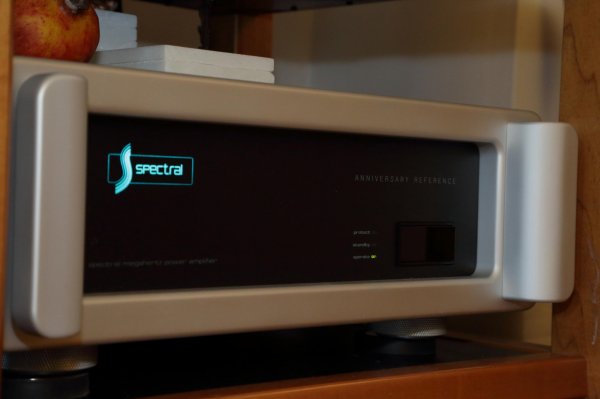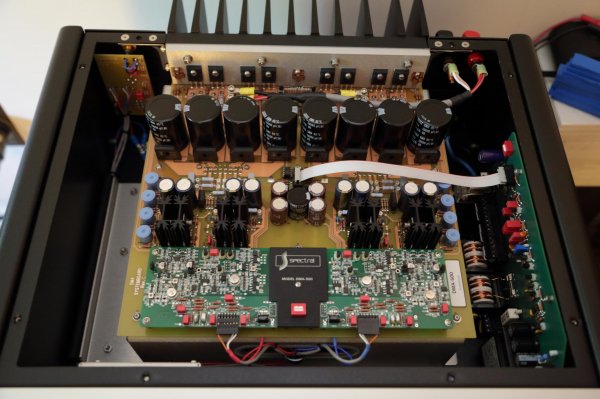The DMA-500 Anniversary Reference
INITIAL IMPRESSIONS
These amps arrived a while ago, but I have not had a chance to listen for too long, due to contractor work in the house and one of the ML panels going bad the other day, with heavy disortion at certain frequencies - these last 15-20 years, and mine are in that range. The unfortunate thing is that it won't be before August that I get the replacements, though the good news is that all other parts are still stocked at Martin Logan and the panels will be custom-made.
I also had the pleasure of re-evaluating the 4000SV CD player along with the 500s, and this time, its sonic superiority came shining right through. I would easily rate it above my DAC especially when it comes to control as the signal gets really complicated (Mahler 2nd's finale), and way above the Vivaldi 2.0 that I also had in here a couple of years ago. The most fascinating aspect of the 4000SV over my DAC is the low-end punch, control and pitch definition, which had me smiling at the quality of bass I have been able to build into these speakers, something that I was not aware of before.
Back to the amps... I am told these ARs are limited-edition, but I have to assume they will have to make more "regular" versions - that's my guess. To cut to the chase, the dealer brands these "super amps", "pure and natural" sounding. I would simply say that, with the advent of the SV technology, finally their solid state designs have been fully tamed. That in itself is a major breakthrough. On the downside, as I've written herein, the midrange sounded over many auditions with the M3s "weird", and we have since then traced it to the expensive MIT speaker cables, and that silly 2C3D thing - nothing to do with the amps or the M3s.
In this system so far, the 500s sound like a refined pair of 400s, less shouty, with more treble control but higher resolution as well, exceptional bass control, very clear sound, and truly render what I have been chasing for decades:
Timbre and Articulation. The completeness of notes, when the recording is up to it, is arresting; that elusive perfect leading edge is there - the bells in the Reference Recordings Fantastique LP are very believable. String tone as well. Timpani rise, sustain and decay, so clear. And voices, oh so natural... But let me take a step back: the slew rate of these amps is claimed to be 1200V/usec, above the 30SV preamp's 1000V/usec, and double the 400's. Settling time is claimed to be <300 nano seconds, slightly higher than the 400's. The dealer claims distortion levels are also lower than the preamp's.
If I were to pick one word to describe the 500s, it would be "Scary". Scary realistic, and scary in power and impact. I was literally frightened to play my friend Al's Rihm Tutuguri CD, and I think that may have dealt the panels the coup de grace. I have gone from "Gosh, these amps shut down on me" during my in-store auditions with the M3s, to "Thank God, these amps will shut down" and protect your speakers.
Over the years, and having seen other owners' trials and tribulations when veering off Spectral's guidance on how their amps need to be driven, I have learned to take their claims in the manual quite seriously. Some key points on the 500s:
Uncompromising audio circuitry must be extremely wideband, but wideband output can broadcast like a transmitter, to produce megahertz oscillations which ring and distort the audio signal. To prevent oscillations [use MIT cables]. Tuning for ultra-high frequency roll-off achieves the best of both words - very fast rise and settling time in the audio circuitry for exceptional signal resolution, and precise bandwidth tailoring for absolute amplifier stability and RFI isolation
The use of Spectral/MIT phase-aligned interconnects and speaker cables is not only recommended, it is mandatory
Tube and most solid-state preamplifiers cannot drive the DMA-500 input circuitry properly ... and are not compatible with Spectral's high-speed amplifier topology, they should not be used [I have heard of input boards in the 400s being blown by tube preamps]. Failure to use a high-current preamplifier may result in serious damage to the output section
Inside the DMA-500 output section are powerful and ultra-fast MegaFet devices... During extreme program dynamics, this arrangements can launch an instantaneous high current drive of up to 90 amps ... with assured precision waveform tracing... Reproduction is highly articulate yet has all the powerful unlimited character of large unlimited capability amplifiers
And a quite-strong a statement from a well-established and humble engineer:
The ultra high-speed and high power capability of the DMA-500 surpass that of all other high-end amplifier designs and set the foundation for a new level of realism and musical resolution
Well, from the little that I've heard in here, I would describe things from a different angle: a) I hear slightly more detail and realism than from the M3s, which has me ordering new panels, but I will go back and re-audition the M3s and focus on the things that I think I hear in here only; b) I still feel a properly crossed-over electrostatic transducer is hard to beat; c) there is very high timbral accuracy and articulation from my analog; d) the superiority of analog over redbook is now more pronounced; e) my wife started dancing with the first Chesky track, and she is completely unaware of the amplifier swap - thank you Spectral for making all your amps look the same!
Years ago I said the 400s are one for the history books; the 500s, instead, are museum pieces.
Fascinating achievement by the Spectral engineering team, and an inspiration for me to excel in my line of work.





